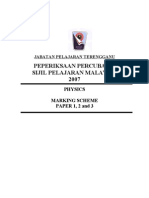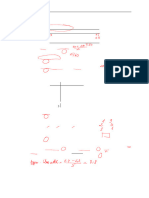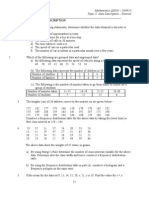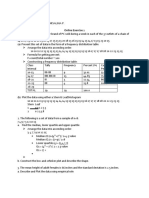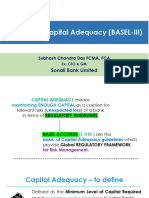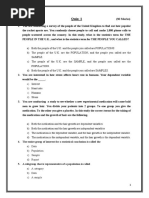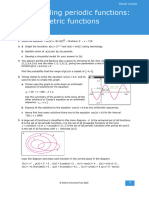FBQT 1024 - Basic Statistics: Chapter 2 - Describing Data Using Tables and Graphs
Uploaded by
Aditya MajumderFBQT 1024 - Basic Statistics: Chapter 2 - Describing Data Using Tables and Graphs
Uploaded by
Aditya MajumderFBQT 1024 – Basic Statistics
Chapter 2 - Describing Data using Tables and Graphs
1. The following data represent the marital status of selected staff in Segi College:
Display the following data on frequency table and draw a pie chart.
2. By using Sturge’s rule, find the number of class intervals (round up your answer) for a frequency
distribution table with data having
a. 17 observations
b. 26 observations
c. 49 observations
d. 88 observations
3. Given below is the relative frequency histogram for the amount of annual leave days for 50 staff in
Citizen Company.
a. Prepare a frequency distribution table for the following data.
b. Calculate the cumulative frequency and cumulative relative frequency.
FBQT 1024 – Basic Statistics
4. Based on the table below:
Class Limit Frequency
11 – 16 8
17 – 22 13
23 – 28 8
29 – 34 6
35 – 40 3
41 – 46 1
47 – 52 1
TOTAL 40
a. Calculate the relative frequency and percentage.
b. Draw a relative frequency histogram and a relative frequency polygon for the data on the same
graph.
5. The following data records the amount of electric bills (rounded to the nearest RM) for the past one
month for 30 families.
a. Construct a frequency distribution table by taking 21 as the lower limit of the first class and 10 as
the width of each class (inclusive class interval).
b. Construct a cumulative frequency distribution table and represent it graphically.
c. What percentage of the families have a monthly electric bill of :
(i) RM61 or more? (ii) RM40 or less?
6. Construct a ranked stem-and-leaf display for the hours that 20 students spent studying for a marketing
test.
7. Draw a two-sided stem-and-leaf plot for the data.
Brand A: 9, 13, 14, 15, 16, 16, 17, 19, 20, 21, 21,22, 25, 25, 26
Brand B: 14, 16, 17, 18, 18, 20, 20, 24, 29
End of questions
You might also like
- Using Venn Diagrams To Solve Probability ProblemsNo ratings yetUsing Venn Diagrams To Solve Probability Problems15 pages
- Assignment 1 (Group Assignment) FBQT 1024 - Basic Statistics100% (1)Assignment 1 (Group Assignment) FBQT 1024 - Basic Statistics3 pages
- Terangganu-Answer Physics P2-Trial SPM 2007100% (1)Terangganu-Answer Physics P2-Trial SPM 200715 pages
- Course Outline DEE40082 (SESI I 2022-2023)No ratings yetCourse Outline DEE40082 (SESI I 2022-2023)4 pages
- LAb - 02 - Voltage and Current Divider RuleNo ratings yetLAb - 02 - Voltage and Current Divider Rule6 pages
- TRIAL STPM Mathematics M 2 (NSEMBILAN) SMK TgDurahSerembanNo ratings yetTRIAL STPM Mathematics M 2 (NSEMBILAN) SMK TgDurahSeremban14 pages
- SA SA SA SA1 1 1 1 Data Analysis Data Analysis Data Analysis Data AnalysisNo ratings yetSA SA SA SA1 1 1 1 Data Analysis Data Analysis Data Analysis Data Analysis39 pages
- QBM 101 Business Statistics: Department of Business Studies Faculty of Business, Economics & Accounting HE LP UniversityNo ratings yetQBM 101 Business Statistics: Department of Business Studies Faculty of Business, Economics & Accounting HE LP University34 pages
- Understandable Statistics Brase 11th Edition Solutions Manual PDF Download Full Book with All Chapters100% (6)Understandable Statistics Brase 11th Edition Solutions Manual PDF Download Full Book with All Chapters49 pages
- Kwok Tak Seng Catholic Secondary School F.2 Mathematics Chapter 10 - Construction and Interpretation of Simple Diagrams and GraphsNo ratings yetKwok Tak Seng Catholic Secondary School F.2 Mathematics Chapter 10 - Construction and Interpretation of Simple Diagrams and Graphs4 pages
- Complete Answer Guide for Understandable Statistics Brase 11th Edition Solutions Manual100% (11)Complete Answer Guide for Understandable Statistics Brase 11th Edition Solutions Manual45 pages
- Understandable Statistics Brase 11th Edition Solutions Manual instant download100% (2)Understandable Statistics Brase 11th Edition Solutions Manual instant download41 pages
- Access Understandable Statistics Brase 11th Edition Solutions Manual All Chapters Immediate PDF Download100% (6)Access Understandable Statistics Brase 11th Edition Solutions Manual All Chapters Immediate PDF Download50 pages
- Understandable Statistics Brase 11th Edition Solutions Manual - Read Now With The Full Version Of All Chapters100% (5)Understandable Statistics Brase 11th Edition Solutions Manual - Read Now With The Full Version Of All Chapters45 pages
- Understandable Statistics Brase 11th Edition Solutions Manual - Full Version Is Now Available For Download100% (2)Understandable Statistics Brase 11th Edition Solutions Manual - Full Version Is Now Available For Download47 pages
- Xii - Statics Target Paper 2024 by (Bagad Billa Group)No ratings yetXii - Statics Target Paper 2024 by (Bagad Billa Group)7 pages
- Understandable Statistics Brase 11th Edition Solutions Manual all chapter instant download100% (14)Understandable Statistics Brase 11th Edition Solutions Manual all chapter instant download48 pages
- Download full Understandable Statistics Brase 11th Edition Solutions Manual (PDF) with all chapters100% (3)Download full Understandable Statistics Brase 11th Edition Solutions Manual (PDF) with all chapters33 pages
- The Institute of Finance Management (Ifm) Department of Mathematics MTT 04101: Tutorial Questions For 13 - 17 2020No ratings yetThe Institute of Finance Management (Ifm) Department of Mathematics MTT 04101: Tutorial Questions For 13 - 17 20201 page
- Ghana Christian International High SchoolNo ratings yetGhana Christian International High School3 pages
- Eps B301 Main Exams Sem2 Yr 2021-22 - Jan22No ratings yetEps B301 Main Exams Sem2 Yr 2021-22 - Jan223 pages
- Mf004 - Introduction To Probability and Statistics Tutorial 2 of Chapter 2No ratings yetMf004 - Introduction To Probability and Statistics Tutorial 2 of Chapter 24 pages
- Assignment/ Tugasan - Statistics/StatistikNo ratings yetAssignment/ Tugasan - Statistics/Statistik10 pages
- Bachelor of Computer Applications (BCA) (Revised) Term-End Examination June, 2021 Bcs-040: Statistical TechniquesNo ratings yetBachelor of Computer Applications (BCA) (Revised) Term-End Examination June, 2021 Bcs-040: Statistical Techniques5 pages
- Grouped and Ungrouped Data (Find Out Mean, Median, Mode)67% (3)Grouped and Ungrouped Data (Find Out Mean, Median, Mode)3 pages
- Examples of Descriptive and Inferential StatisticsNo ratings yetExamples of Descriptive and Inferential Statistics2 pages
- Philippine Amusement and Gaming Corporation, G.R. No. 151030No ratings yetPhilippine Amusement and Gaming Corporation, G.R. No. 15103019 pages
- Practical Work in Geography Ch-6 Gis NewNo ratings yetPractical Work in Geography Ch-6 Gis New44 pages
- Lr2170sa 4ah Specification Sheet TranslatedNo ratings yetLr2170sa 4ah Specification Sheet Translated15 pages
- Fake Account Detection Using Machine Learning Techniques100% (1)Fake Account Detection Using Machine Learning Techniques7 pages
- New Mexico v. Wilson, No. S-1-SC-38510 (N.M. June 7, 2021)No ratings yetNew Mexico v. Wilson, No. S-1-SC-38510 (N.M. June 7, 2021)55 pages
- Mechanic (HT, LT Equipments and Cable Jointing)No ratings yetMechanic (HT, LT Equipments and Cable Jointing)43 pages
- Seamless and Welded Precision Steel Tubesfor Hydraulic and Pneumatic ApplicationsNo ratings yetSeamless and Welded Precision Steel Tubesfor Hydraulic and Pneumatic Applications20 pages
- Pretest Letter To Parents For ScholasticNo ratings yetPretest Letter To Parents For Scholastic2 pages
- Lab 1: Pulse Width Modulation (PWM) : ENGR 1000: Electrical and Computer Engineering ModuleNo ratings yetLab 1: Pulse Width Modulation (PWM) : ENGR 1000: Electrical and Computer Engineering Module4 pages
- Property Information Project Scope of Work: Jay Residence 5911 Lancashire Ave, Westminster, Ca 92683No ratings yetProperty Information Project Scope of Work: Jay Residence 5911 Lancashire Ave, Westminster, Ca 926837 pages
- 2023-BA-C4 - Elicitation and CollaborationNo ratings yet2023-BA-C4 - Elicitation and Collaboration75 pages









